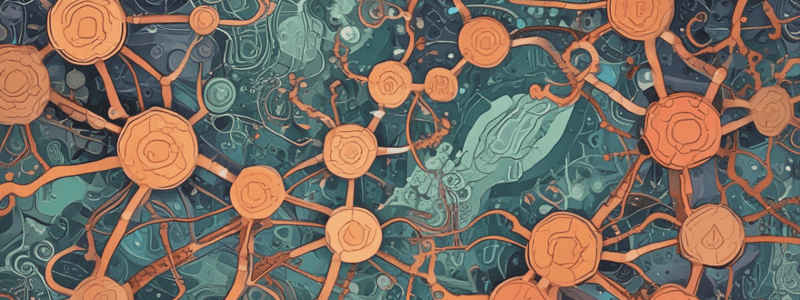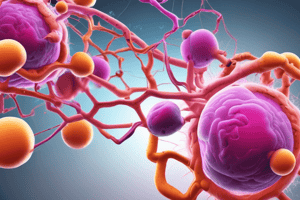Podcast
Questions and Answers
What is the primary consequence of aldolase B deficiency in fructose metabolism?
What is the primary consequence of aldolase B deficiency in fructose metabolism?
- Prolonged ATP deficiency (correct)
- Normal ATP levels
- Enhanced glucose conversion
- Increased ATP synthesis
Which statement correctly describes the function of fructokinase in fructose metabolism?
Which statement correctly describes the function of fructokinase in fructose metabolism?
- It reduces the rate of fructose entry into hepatocytes.
- It directly depletes ATP levels.
- It increases the levels of inorganic phosphate.
- It catalyzes the reaction converting fructose to fructose 1-phosphate. (correct)
How does a deficiency in aldolase B affect thermodynamics in the cell?
How does a deficiency in aldolase B affect thermodynamics in the cell?
- It leads to many reactions becoming thermodynamically unfavorable. (correct)
- It makes all reactions thermodynamically favorable.
- It increases the availability of ATP for cellular processes.
- It creates a permanent state of equilibrium.
According to the second law of thermodynamics, how do cells maintain order?
According to the second law of thermodynamics, how do cells maintain order?
What reaction characteristic is indicated by a positive change in free energy (ΔG)?
What reaction characteristic is indicated by a positive change in free energy (ΔG)?
What occurs when the change in free energy (ΔG) is zero?
What occurs when the change in free energy (ΔG) is zero?
Which of the following best describes fructose 1-phosphate accumulation in the cell?
Which of the following best describes fructose 1-phosphate accumulation in the cell?
If compound A has a higher free energy than compound B, what can be inferred if the ΔG of A → B is -5 kcal/mol?
If compound A has a higher free energy than compound B, what can be inferred if the ΔG of A → B is -5 kcal/mol?
Which of the following statements is true regarding catabolic reactions?
Which of the following statements is true regarding catabolic reactions?
Why are fats considered more energy dense than carbohydrates?
Why are fats considered more energy dense than carbohydrates?
In oxidation-reduction reactions, what happens to carbon-hydrogen bonds?
In oxidation-reduction reactions, what happens to carbon-hydrogen bonds?
How does fatty acid oxidation stimulate gluconeogenesis?
How does fatty acid oxidation stimulate gluconeogenesis?
What is a key difference between fructokinase deficiency and aldolase B deficiency?
What is a key difference between fructokinase deficiency and aldolase B deficiency?
What is the consequence of aldolase B deficiency upon fructose ingestion?
What is the consequence of aldolase B deficiency upon fructose ingestion?
Which of the following is a symptom associated with aldolase B deficiency?
Which of the following is a symptom associated with aldolase B deficiency?
Which process is NOT affected by low levels of ATP?
Which process is NOT affected by low levels of ATP?
What is the primary function of catabolic reactions in the body?
What is the primary function of catabolic reactions in the body?
Why are fats considered to be more energy dense compared to carbohydrates?
Why are fats considered to be more energy dense compared to carbohydrates?
What is the role of NADPH in anabolic reactions?
What is the role of NADPH in anabolic reactions?
What occurs during oxidative reactions associated with catabolic pathways?
What occurs during oxidative reactions associated with catabolic pathways?
What is the main outcome of gluconeogenesis?
What is the main outcome of gluconeogenesis?
How does a deficiency in ATP affect cellular function?
How does a deficiency in ATP affect cellular function?
What is primarily affected by the Na+/K+ ATPase when ATP levels are low?
What is primarily affected by the Na+/K+ ATPase when ATP levels are low?
What are the predominant fuel sources during catabolism?
What are the predominant fuel sources during catabolism?
Flashcards are hidden until you start studying
Study Notes
Metabolism Overview and Objectives
- Aldolase B deficiency has severe effects compared to fructokinase deficiency due to significant ATP depletion after fructose, sucrose, or sorbitol ingestion.
- Energetic imbalances in cells do not violate the first and second laws of thermodynamics; cells maintain energy balance through heat generation that increases overall entropy.
- Spontaneity of a reaction can be predicted by its change in free energy (𝚫G); negative 𝚫G indicates a spontaneous reaction, while positive requires energy input.
- Exergonic reactions release energy (negative 𝚫G), while endergonic reactions absorb energy (positive 𝚫G).
- Coupling endergonic reactions with ATP hydrolysis makes them thermodynamically favorable, allowing otherwise unfavorable reactions to proceed.
Disorders of Fructose Metabolism
-
Fructokinase deficiency:
- Autosomal recessive disorder leading to fructose accumulation in urine.
- Generally benign, affecting approximately 1 in 30,000 live births.
-
Aldolase B deficiency:
- Autosomal recessive disorder, prevents conversion of fructose 1-P into glyceraldehyde and dihydroxyacetone phosphate.
- More severe than fructokinase deficiency, affects around 1 in 20,000 live births.
- Symptoms include renal dysfunction, hyperuricemia, hypoglycemia, lactic acidemia, liver failure, jaundice, and can lead to death upon ingestion of fructose.
Metabolism and Thermodynamics
- The first law of thermodynamics states that energy is conserved; it cannot be created or destroyed.
- The second law indicates that entropy in a system increases over time; cells increase order while balancing entropy changes in their environment.
- A decrease in cellular entropy necessitates the release of heat to maintain overall energy balance.
Chemical Reactions and Free Energy
- Gibbs free energy (G) indicates the work potential of a reaction; 𝚫G changes as reactions occur.
- At equilibrium, 𝚫G equals zero; reactions with negative 𝚫G proceed spontaneously, while positive 𝚫G reactions need energy input.
- ATP deficiency disrupts critical cellular functions, including enzyme activity and ion balance, leading to cell swelling and potential rupture.
Metabolic Pathways
- Metabolic pathways consist of anabolic (storage) and catabolic (mobilization) reactions.
- High glucose levels lead to storage for future energy needs; conversely, low glucose levels trigger mobilization of stored energy.
- ATP/NADH/NADPH generation is vital for maintaining metabolic processes.
Intermediary Metabolism
- Pathways are interlinked; regulated and reversible steps play crucial roles in metabolic control.
- Key reactions include hydrolysis of complex molecules in catabolic processes and synthesis of complex products in anabolic reactions.
- Catabolic reactions: Breakdown of molecules (e.g., proteins to amino acids) and oxidation reactions generating ATP.
- Anabolic reactions: Synthesis of complex products from simpler substrates, requiring energy input typically involving NADPH for high-energy electrons.
Energy Density of Fats vs. Carbohydrates
- Fats are more energy dense than carbohydrates due to greater hydrogen content and higher caloric yield per gram.
- In a typical 70 kg male: approximately 30 kg of muscle and 10 kg of fat illustrate fuel reserves during metabolic processes.
Studying That Suits You
Use AI to generate personalized quizzes and flashcards to suit your learning preferences.


